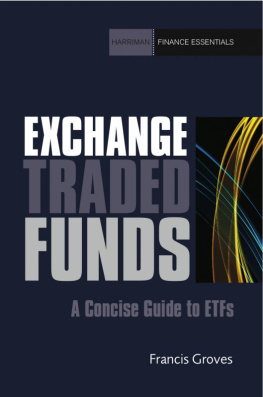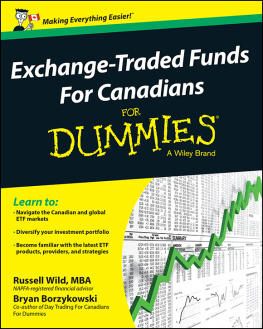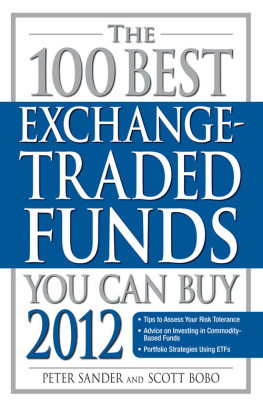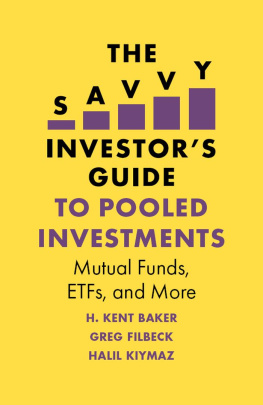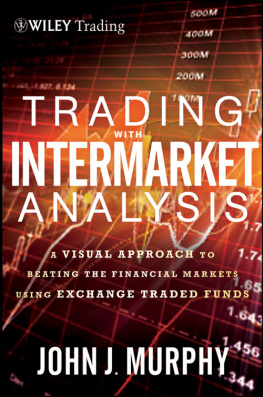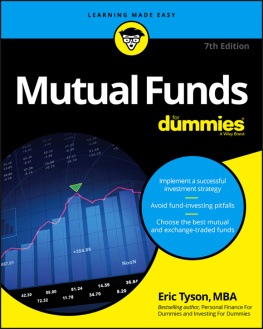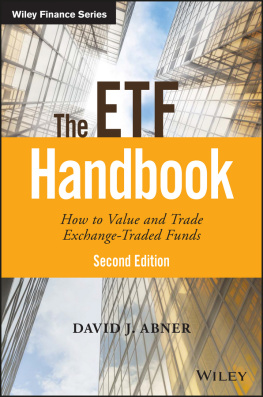Francis Groves - Exchange Traded Funds: A Concise Guide to ETFs
Here you can read online Francis Groves - Exchange Traded Funds: A Concise Guide to ETFs full text of the book (entire story) in english for free. Download pdf and epub, get meaning, cover and reviews about this ebook. year: 2011, publisher: HarrimanHouse, genre: Romance novel. Description of the work, (preface) as well as reviews are available. Best literature library LitArk.com created for fans of good reading and offers a wide selection of genres:
Romance novel
Science fiction
Adventure
Detective
Science
History
Home and family
Prose
Art
Politics
Computer
Non-fiction
Religion
Business
Children
Humor
Choose a favorite category and find really read worthwhile books. Enjoy immersion in the world of imagination, feel the emotions of the characters or learn something new for yourself, make an fascinating discovery.
- Book:Exchange Traded Funds: A Concise Guide to ETFs
- Author:
- Publisher:HarrimanHouse
- Genre:
- Year:2011
- Rating:4 / 5
- Favourites:Add to favourites
- Your mark:
- 80
- 1
- 2
- 3
- 4
- 5
Exchange Traded Funds: A Concise Guide to ETFs: summary, description and annotation
We offer to read an annotation, description, summary or preface (depends on what the author of the book "Exchange Traded Funds: A Concise Guide to ETFs" wrote himself). If you haven't found the necessary information about the book — write in the comments, we will try to find it.
Exchange Traded Funds: A Concise Guide to ETFs — read online for free the complete book (whole text) full work
Below is the text of the book, divided by pages. System saving the place of the last page read, allows you to conveniently read the book "Exchange Traded Funds: A Concise Guide to ETFs" online for free, without having to search again every time where you left off. Put a bookmark, and you can go to the page where you finished reading at any time.
Font size:
Interval:
Bookmark:

HARRIMAN HOUSE LTD
3A Penns Road
Petersfield
Hampshire
GU32 2EW
GREAT BRITAIN
Tel: +44 (0)1730 233870
Fax: +44 (0)1730 233880
Email: enquiries@harriman-house.com
Website: www.harriman-house.com
First published in Great Britain in 2011
Copyright Harriman House Ltd
The right of Francis Groves to be identified as the author has been asserted in accordance with the Copyright, Designs and Patents Act 1988.
978-0-85719-113-4
British Library Cataloguing in Publication Data
A CIP catalogue record for this book can be obtained from the British Library.
All rights reserved; no part of this publication may be reproduced, stored in a retrieval system, or transmitted in any form or by any means, electronic, mechanical, photocopying, recording, or otherwise without the prior written permission of the Publisher. This book may not be lent, resold, hired out or otherwise disposed of by way of trade in any form of binding or cover other than that in which it is published without the prior written consent of the Publisher.
No responsibility for loss occasioned to any person or corporate body acting or refraining to act as a result of reading material in this book can be accepted by the Publisher, by the Author, or by the employer of the Author.
Francis Groves studied modern history at the London School of Economics and has many years of experience working for legal and financial publishers including Reuters, the Financial Times and Butterworths. He has written on overseas property investment and created financial literacy training materials. The interaction of politics and finance is a particular interest for him. Francis enjoys reading history and walking in his spare time.
This is an introduction to exchange traded funds (ETFs), the latest generation of collective investments. The aim of this book is to show how ETFs are constructed, the way they work and the different asset classes ETFs now cover.
The main focus of the book is on ETFs that track indices, as these are undoubtedly the most important in terms of their range, the amounts of money invested and the advantages they offer. Further, every ETFs performance is inextricably linked to the index it tracks. The principle that to understand an ETF it is also necessary to thoroughly understand the underlying index is a key theme of this guide and the workings of several kinds of index are examined.
The range of ETFs described here include those tracking indices for equities, fixed interest securities, money markets, currencies, credit markets, property and commodity futures. ETFs offering methods of imitating hedging strategies are also explained, together with the new generation of active (as opposed to index tracking) ETFs. Of these ETFs for various asset types, by far the most important are those that track equities. For this reason, the main focus of this book is on equities and readers should assume that the book is referring to equity ETFs unless otherwise stated. For more on the prevalence of equity ETFs see A perspective on the different ETF asset classes.
Most of the ETFs covered in this book are listed on the London Stock Exchange (LSE). However, most ETF providers are not UK businesses and most London-listed ETFs are domiciled in other European Union (EU) member states (which means the ETFs are legally registered outside the UK). For this reason, careful attention has been paid to the European Union and UK regulatory framework that ETFs operate under. At points throughout the book I refer to European ETFs these ETFs are available to UK investors, but since they are regulated in the same way throughout the EU it is helpful to refer to them as European ETFs (as distinct from American ETFs, which are regulated differently). This distinction between European and American ETFs is important because one of the broadest divisions between types of ETFs is that between those in Europe and America the history of ETFs, their regulation and how the funds operate is different in the US.
This does not mean we will ignore American ETFs altogether. Two of the most important ETF providers in the UK are American companies Blackrock iShares and Invesco Powershares. Also, many of the important developments in ETFs have taken place in the United States and many of the cutting edge ETF refinements are taking place there. This being the case, the guide provides the American context to important ETF developments.
The book is for professional investors, financial advisors and others involved in the finance industry who need a basic overview of the ETF world.
ETFs are explained in a way that will make sense to those who are conversant with portfolios of individual stocks or retail products such as investment funds, but this guide will be equally accessible to those whose investments are entirely made up of exchange traded products.
Part one begins by placing ETFs in the context of older forms of collective investments. Chapter 1 shows how the characteristics of ETFs developed from what investment trusts, investment funds (or unit trusts) and index tracking had to offer. Core concepts such as benchmarking are explained.
Chapter 2 provides an overview of equity indices the key to equity ETF differentiation and a cornerstone of the ETF industry.
Chapter 3 looks at the main parties involved in ETF creation and the main types of ETF construction, specifically with reference to equity ETFs (by far the largest type of ETF in terms of assets under management). Familiarity with ETF construction methods is important for understanding the risks involved when investing in ETFs. This thorough examination of ETF construction methods also covers how ETFs handle discounts and premiums to net asset value (NAV), a key advantage of ETFs in comparison to investment trusts.
Having looked at the origins of ETFs and how they are created in part one, part two examines the main asset classes that are covered by ETF investing.
Chapter 4 moves on from equity ETFs to look at other asset classes covered by the industry, such as fixed-income and money-market ETFs. Exchange traded products in commodities have a separate section devoted to them (Chapter 5) in order to do justice to the special characteristics of these funds and the indices they track. These asset types are key areas opened up by ETFs and these chapters of the guide are designed to forearm readers with essential information about them.
Chapter 6 then takes a look at some of the more advanced types of exchanged traded fund.
Part three looks at the practicalities of buying ETFs and how to find out more about individual funds.
In Chapter 7 the practicalities of ETF investing are discussed, including how ETFs can be used by investors, and when and how often ETFs might be traded. Readers may find it helpful to read the Searching for an ETF text box, as this explains how ETF names are constructed.
For many, ETFs present completely new opportunities for acquiring overseas assets so careful thought is given to ETFs and foreign currency considerations in Chapter 8. Attention is also given to the complex area of ETF liquidity.
Chapter 9 draws together conclusions about different types of ETF investment and analyses some broad implications that ETFs have for the investment industry in the future.
Font size:
Interval:
Bookmark:
Similar books «Exchange Traded Funds: A Concise Guide to ETFs»
Look at similar books to Exchange Traded Funds: A Concise Guide to ETFs. We have selected literature similar in name and meaning in the hope of providing readers with more options to find new, interesting, not yet read works.
Discussion, reviews of the book Exchange Traded Funds: A Concise Guide to ETFs and just readers' own opinions. Leave your comments, write what you think about the work, its meaning or the main characters. Specify what exactly you liked and what you didn't like, and why you think so.

